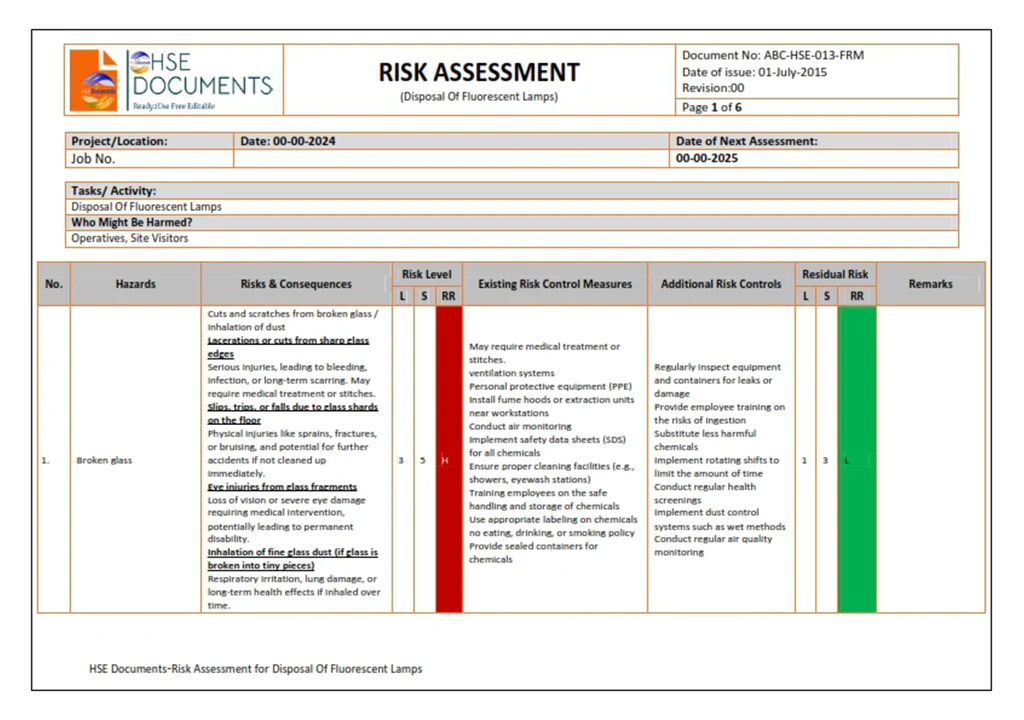1.0. HAZARDS
1.1. Broken glass
1.2. Environmental pollution
1.3. Absorption/Inhalation of Hazardous Substances
2.0. RISKS AND CONSEQUENCES
2.1. Cuts and scratches from broken glass/inhalation of dust
2.2. Lacerations or cuts from sharp glass edges
2.3. Serious injuries, leading to bleeding, infection, or long-term scarring. It may require medical treatment or stitches.
2.4. Slips, trips, or falls due to glass shards on the floor
2.5. If not cleaned up immediately, physical injuries like sprains, fractures, or bruising, and the potential for further accidents.
2.6. Eye injuries from glass fragments
2.7. Loss of vision or severe eye damage requiring medical intervention, potentially leading to permanent disability.
2.8. Inhalation of fine glass dust (if the glass is broken into tiny pieces)
2.9. Respiratory irritation, lung damage, or long-term health effects if inhaled over time.
2.10. Fire hazard if electrical equipment comes into contact with broken glass
2.11. Electrical short-circuit fire hazards, damage to equipment, and potential for serious injury or property loss.
2.12. Air Pollution (emissions from machinery or vehicles)
2.13. Respiratory issues, health problems in workers and nearby communities, and contribution to climate change.
2.14. Water Pollution (spillages of chemicals or waste into water sources)
2.15. Contamination of drinking water, harm to aquatic life, and soil contamination.
2.16. Soil Contamination (improper disposal of hazardous waste)
2.17. Long-term damage to soil quality, impact on agriculture, and harm to local ecosystems.
2.18. Noise Pollution (excessive noise from construction or industrial activities)
2.19. Hearing loss, increased stress, and disruption to local communities and wildlife.
2.20. Improper Waste Management (littering or improper waste disposal)
2.21. Pollution of local areas, harm to wildlife, and contribution to landfill overload.
Respiratory Issues:
2.22. Exposure to hazardous substances may lead to respiratory problems, including asthma, bronchitis, or long-term lung damage.
Skin Irritation or Chemical Burns:
2.23. Contact with hazardous substances may cause skin irritation, rashes, or chemical burns.
Toxicity or Poisoning:
2.24. Inhalation of toxic substances can lead to poisoning, affecting vital organs like the liver, kidneys, or nervous system.
Allergic Reactions:
2.25. Some substances may cause severe allergic reactions, including anaphylaxis.
Chronic Health Conditions:
2.26. Prolonged exposure may result in long-term conditions like cancer or reproductive harm.
2.27. Health deterioration (short-term and long-term).
2.28. Loss of productivity due to worker absence or reduced capacity.
2.29. Increased liability for the organization.
2.30. Damage to company reputation due to health-related incidents.
3.0. EXISTING RISK CONTROL MEASURES
3.1. May require medical treatment or stitches.
3.2. Ventilation systems
3.3. Personal protective equipment (PPE)
3.4. Install fume hoods or extraction units near workstations
3.5. Conduct air monitoring
3.6. Implement safety data sheets (SDS) for all chemicals
3.7. Ensure proper cleaning facilities (e.g., showers, eyewash stations)
3.8. Training employees on the safe handling and storage of chemicals
3.9. Use appropriate labeling on chemicals
3.10. No eating, drinking, or smoking policy
3.11. Provide sealed containers for chemicals
3.12. Regular maintenance of machinery and vehicles to reduce emissions.
3.13. Use of low-emission fuels and technologies.
3.14. Implementing air quality monitoring programs.
3.15. Use of personal protective equipment (PPE) such as respirators where necessary.
3.16. Proper storage and handling of chemicals.
3.17. Spill containment and clean-up procedures are in place.
3.18. Regular inspections of storage tanks and pipelines.
3.19. Installation of filtration systems to treat water before disposal.
3.20. Safe disposal and recycling of hazardous materials.
3.21. Use of secure, sealed waste containers.
3.22. Regular waste audits to ensure compliance with environmental regulations.
3.23. Employee training on safe waste management practices.
3.24. Installation of noise barriers and soundproofing.
3.25. Use of quieter machinery and equipment.
3.26. Regular monitoring of noise levels around the workplace.
3.27. Enforcing noise limits during off-hours to reduce disturbance.
3.28. Implementing proper waste segregation (recyclable, non-recyclable, and hazardous).
3.29. Regular waste collection and disposal schedules.
3.30. Promoting waste reduction initiatives within the organization.
3.31. Employee awareness campaigns on the importance of proper waste disposal.
Engineering Controls:
3.32. Install proper ventilation systems, including local exhaust ventilation, to reduce airborne contaminants.
3.33. Use enclosed systems for processes involving hazardous substances.
Administrative Controls:
3.34. Develop and enforce a Hazard Communication Program (HCP).
3.35. Train employees on the risks, symptoms, and safe handling of hazardous substances.
3.36. Limit exposure time through job rotation or scheduling.
Personal Protective Equipment (PPE):
3.37. Provide appropriate PPE, such as respirators, gloves, goggles, and protective clothing.
3.38. Ensure PPE is properly maintained and fitted to employees.
Monitoring and Detection:
3.39. Conduct regular air quality testing and substance exposure monitoring.
3.40. Use alarms or detectors for the presence of hazardous vapors or gases.
Emergency Preparedness:
3.41. Provide eyewash stations and safety showers in areas with hazardous substances.
3.42. Develop and practice spill response and first-aid procedures.
3.43. Maintain an accessible Material Safety Data Sheet (MSDS) repository for all substances.
4.0. ADDITIONAL RISK CONTROLS
4.1. Regularly inspect equipment and containers for leaks or damage
4.2. Provide employee training on the risks of ingestion
4.3. Substitute less harmful chemicals
4.4. Implement rotating shifts to limit the amount of time
4.5. Conduct regular health screenings
4.6. Implement dust control systems such as wet methods
4.7. Conduct regular air quality monitoring
4.8. Supervisors and operatives to be aware of disposal methods and procedures.
4.9. [COMPANY] Management will distribute suitable and sufficient respiratory protection.






1.jpg)


No comments:
Post a Comment